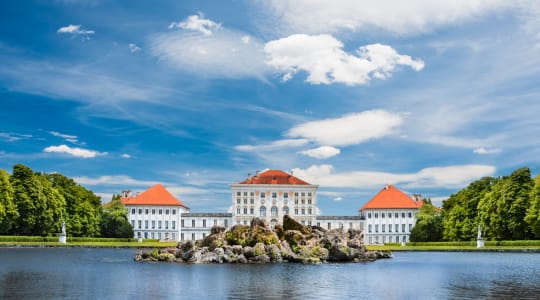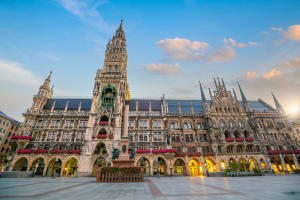
Nymphenburg Palace is a Baroque palace located in Munich, Germany. It was the summer residence of the rulers of Bavaria, and is now open to the public as a museum and tourist attraction.
The palace was commissioned by Ferdinand Maria, Elector of Bavaria, in 1664, and construction began in 1665. It was designed by the Italian architect Agostino Barelli, and later expanded by his successor, Enrico Zuccalli. The palace was completed in 1679, and has since undergone several renovations and expansions.
The palace features a grand central hall, known as the Steinerner Saal, which is adorned with ornate decorations, including frescoes and stucco work. Other notable features of the palace include the Nymphenburg Porcelain Manufactory, which was established in 1747 and is still in operation today, and the Nymphenburg Canal, which runs through the palace grounds.
In addition to the palace itself, visitors can explore the surrounding parklands, which include several ornamental gardens, pavilions, and other buildings. The park is also home to several museums, including the Marstallmuseum, which features a collection of horse-drawn carriages and other equestrian-related artifacts, and the Erwin von Kreibig-Museum, which showcases the history of Nymphenburg porcelain.
Today, Nymphenburg Palace is one of the most popular tourist attractions in Munich, attracting over 300,000 visitors annually. It is also used for state occasions and other formal events, and is regarded as one of the finest examples of Baroque architecture in Germany.
Explore Near Nymphenburg palace
Discover 5 attractions, 5 cities, and 1 airport within 75km. Perfect for planning day trips, finding connecting flights, or discovering new destinations to explore during your visit.
Nearby Attractions & Places to Visit
5 destinations within 4.5km - 5.8km from your location





Nearby Cities Worth Exploring
5 destinations within 5.8km - 63.8km from your location
Airports Near Nymphenburg palace
1 destination within 30.2km from your location
Cross-Border Adventures Near Nymphenburg palace
Discover cross-border adventures near Nymphenburg palace. Explore neighboring countries with similar attractions and extend your travel experience across borders.








And 1 more neighboring countries